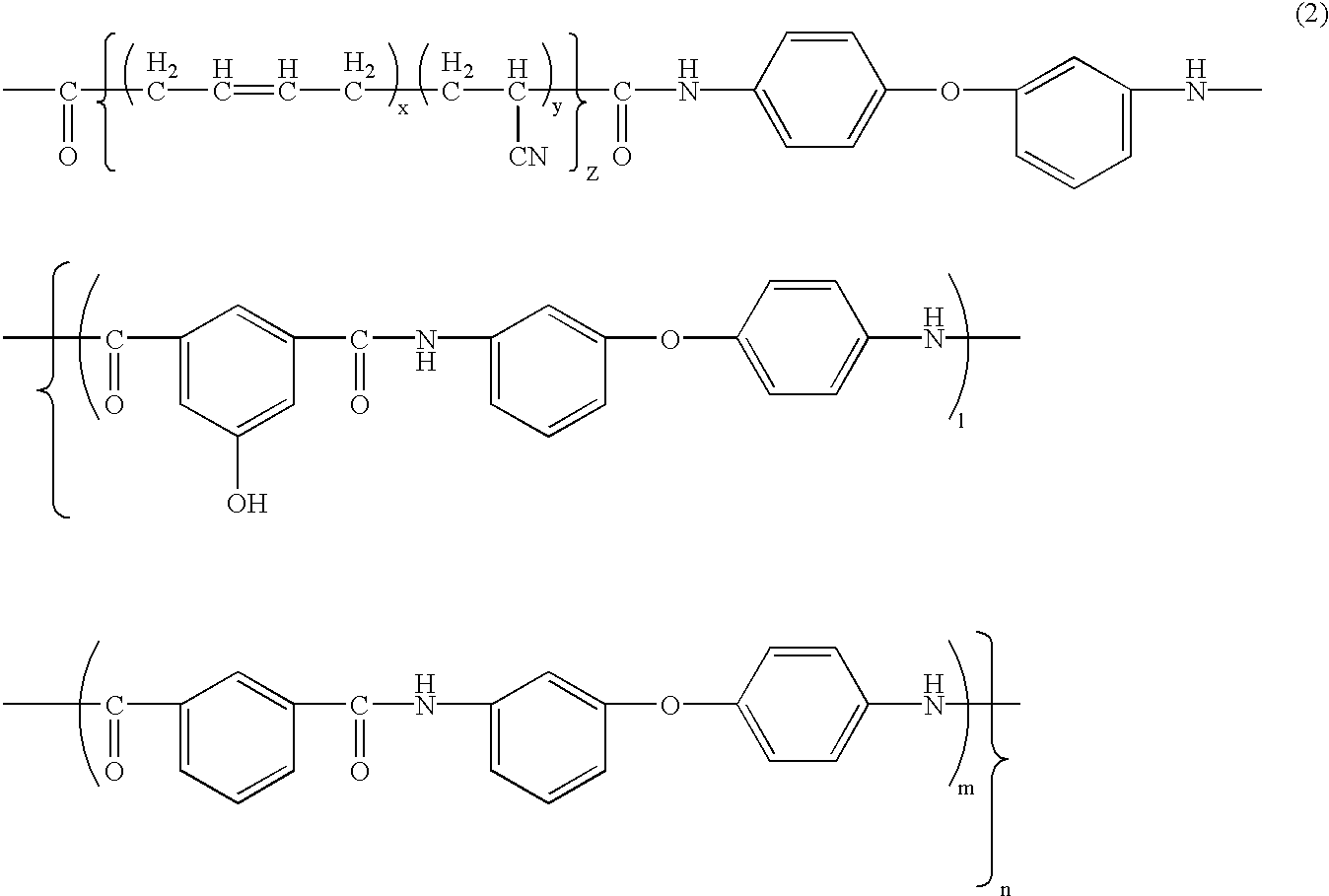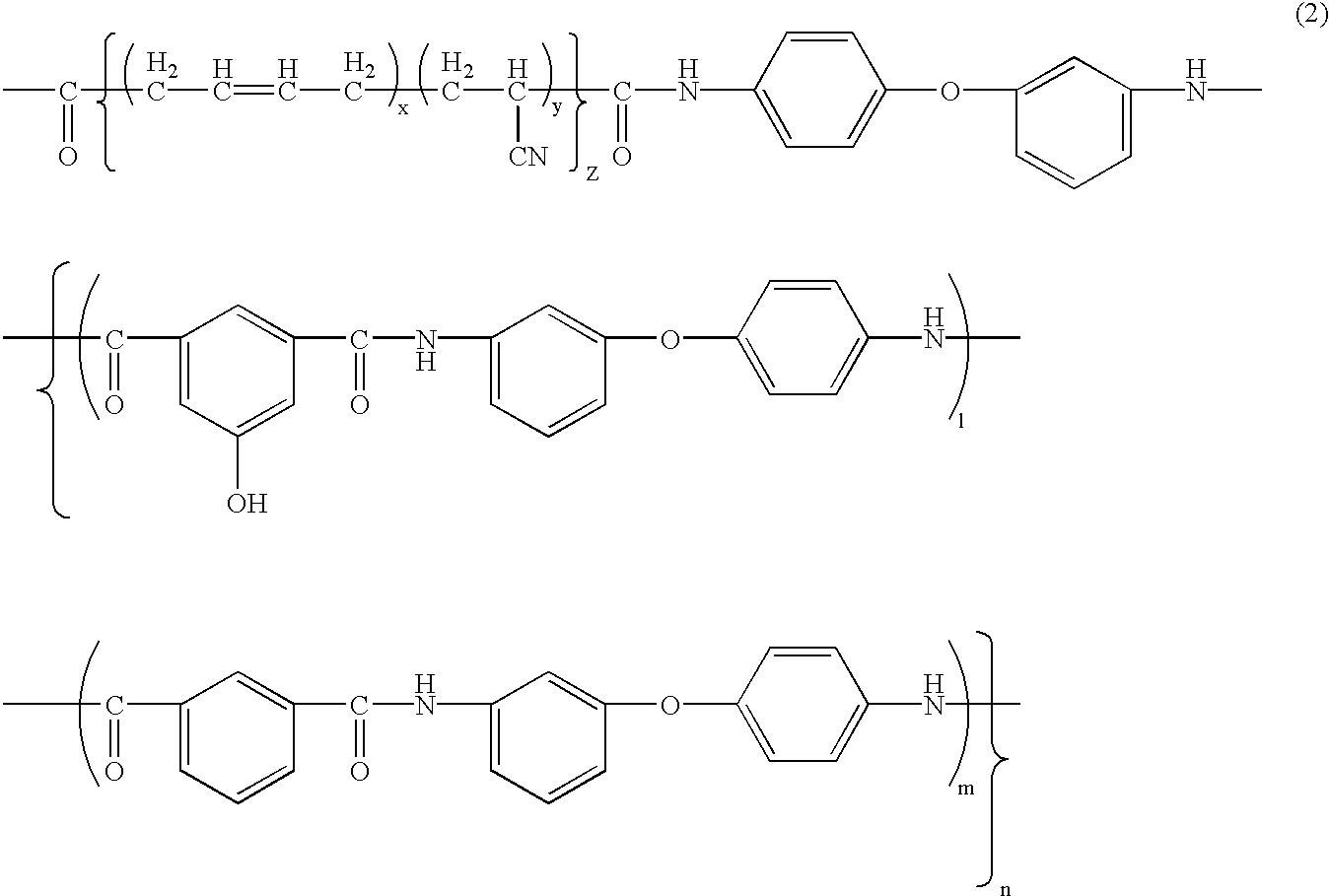Polyamide resin-containing varnish and its use
- Summary
- Abstract
- Description
- Claims
- Application Information
AI Technical Summary
Benefits of technology
Problems solved by technology
Method used
Image
Examples
synthesis example 1
[0091]Synthesis of phenolic hydroxyl group-having aromatic polyamide resin (hereinafter RPAM):
[0092]13.29 g (80 mmols) of isophthalic acid, 31.05 g (10 mmols) of bis(4-amino-3,5-diethylphenyl)methane, 3.64 g (20 mmols) of 5-hydroxyisophthalic acid, 2.50 g of lithium chloride, 7.50 g of calcium chloride, 200 ml of N,N-dimethylacetamide and 30 ml of pyridine were put into a one-liter, four-neck round-bottom flask, and stirred and dissolved, and then 62.05 g (20 mmols) of triphenyl phosphite was added thereto and reacted in a dry nitrogen atmosphere at 100° C. for 3 hours. This was left cooled to room temperature, and diluted with 400 ml of N,N-dimethylacetamide, and then poured into 8 liters of a methanol bath for precipitation with stirring to obtain a crude polymer. This crude polymer was purified in an ordinary manner. Its yield was 43.9 g (99%).
synthesis example 2
[0093]Synthesis of phenolic hydroxyl group-having aromatic polyamide-poly(butadiene-acrylonitrile) block copolymer (hereinafter BPAM: its phenolic hydroxyl group content in the aromatic polyamide moiety is 14 mol %: one example of the copolymer of formula (2)):
[0094]19.93 g (120 mmols) of isophthalic acid, 30.63 g (153 mmols) of 3,4′-diaminodiphenyl ether, 3.64 g (20 mmols) of 5-hydroxyisophthalic acid, 3.9 g of lithium chloride, 12.1 g of calcium chloride, 240 ml of N-methyl-2-pyrrolidone and 54 ml of pyridine were put into a one-liter, four-neck round-bottom flask, and stirred and dissolved, and then 74 g of triphenyl phosphite was added thereto and reacted at 90° C. for 4 hours to produce a phenolic hydroxyl group-having aromatic polyamide oligomer. A solution prepared by dissolving 48 g of a poly)butadiene-acrylonitrile) copolymer having a carboxyl group at both terminals thereof (Hycar CTBN by BF Goodrich: its acrylonitrile content in the poly(butadiene-acrylonitrile) moiety is...
example 1
[0095]160 parts of cyclopentanone (by Nippon Zeon, having a boiling pint of 131° C.) was added to 100.0 parts of Epomic R-302 (bisphenol A-type epoxy resin by Mitsui Chemical, having an epoxy equivalent of 630 g / eq), 16.2 parts of PN-80 (phenol-novolak resin by Nippon Kayaku, having a hydroxyl equivalent of 100 g / eq) and, as a curing promoter, 0.3 parts of 2E4MZ (by Shikoku Kasei; 2-ethyl-4-methylimidazole), and stirred at room temperature and completely dissolved. 50.0 parts of RPAM obtained in Synthesis Example 1 was added to it, and stirred at room temperature and completely dissolved to obtain a polyamide resin-containing varnish of the invention.
[0096]Using an applicator, the thus-obtained polyamide resin-containing varnish was coated onto a PET film, and dried in a hot air-circulating drier at 140° C. for 4 minutes to form an adhesive film having a thickness of 30 μm.
[0097]The adhesive film was released from the PET film, and this was used as a sample for measuring the amount ...
PUM
| Property | Measurement | Unit |
|---|---|---|
| Structure | aaaaa | aaaaa |
| Flexibility | aaaaa | aaaaa |
| Adhesivity | aaaaa | aaaaa |
Abstract
Description
Claims
Application Information
 Login to View More
Login to View More - R&D
- Intellectual Property
- Life Sciences
- Materials
- Tech Scout
- Unparalleled Data Quality
- Higher Quality Content
- 60% Fewer Hallucinations
Browse by: Latest US Patents, China's latest patents, Technical Efficacy Thesaurus, Application Domain, Technology Topic, Popular Technical Reports.
© 2025 PatSnap. All rights reserved.Legal|Privacy policy|Modern Slavery Act Transparency Statement|Sitemap|About US| Contact US: help@patsnap.com



